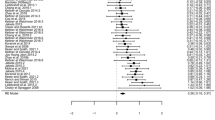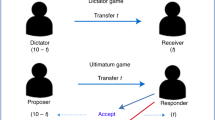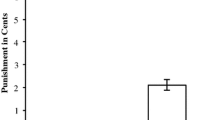Abstract
We replicate Andreoni (Quarterly Journal of Economics 110: 1–21, 1995)’s finding that agents behave more selfishly when taking from a public account than when giving to a public good. Based on a neutral language setting we add new insights into motivations to give or take in a linear public good setting: we find that Andreoni’s result is partly driven by the complete elimination of giving options in the taking frame. However, a pure extension of the action space into the taking domain also leads to a significant increase in selfish behavior.

Similar content being viewed by others
Notes
Subjects were asked to transfer tokens between their private and the group account.
We deliberately chose asymmetric bounds in the negative and positive domain in order to avoid a potential focal point at the mid-point of the action space to coincide with ‘0’ contribution decisions.
We mainly followed the instructions of Fehr and Gächter (2000), but slightly changed the wording. For instance, instead of ‘contributions to a project’, instructions asked participants to divide tokens between a private and a group account. Instructions can be found in Supplementary material.
In case a participant did not answer the questions correctly, a help screen explained the correct answers in detail.
Column (I) takes a most conservative approach by taking the group average of contributions across all periods as dependent variable. Columns (II) and (III) control for interdependencies of decisions across periods by including individual random effects and clustering standard errors at the group level. The results are stable to using different specifications like group average of contributions per period as dependent variable or a linear time trend.
This difference is also found using a Mann–Whitney test based on first period individual contribution levels (p = 0.07), but does not show up when comparing group averages across all periods (p = 0.27). Using the Welch t test appears, however, more appropriate: a Shapiro–Wilk W test cannot reject the hypothesis of normality for both distributions and a Levene’s test shows that the variances of the samples of GIVE and TAKE are not equal (p = 0.014). In this case, Ruxton (2006) and Fagerland and Sandvik (2009) advise using the Welch’s t test for unequal variances instead of the Mann–Whitney test as it performs better than the Mann–Whitney test in terms of controlling Type I errors.
References
Andreoni, J. (1990). Impure altruism and donations to public goods: a theory of warm-glow giving. The Economic Journal, 100, 464–477.
Andreoni, J. (1995). Warm-glow versus cold-prickle: the effects of positive and negative framing on cooperation in experiments. Quarterly Journal of Economics, 110, 1–21.
Bardsley, N. (2008). Dictator game giving: altruism or artifact? Experimental Economics, 11, 122–133.
Cookson, R. (2000). Framing effects in public good experiments. Experimental Economics, 3, 55–79.
Cox, J. C., Ostrom, E., Sadiraj, V., & Walker, J. M. (2013). Provision versus appropriation in symmetric and asymmetric social dilemmas. Southern Economic Journal, 79, 496–512.
Cox, J. C., & Sadiraj, V. (2007). On modeling voluntary contributions to public goods. Public Finance Review, 35, 311–332.
Cubitt, R. P., Drouvelis, M., & Gächter, S. (2011). Framing and free riding: emotional responses and punishment in social dilemma games. Experimental Economics, 14, 254–272.
Dufwenberg, M., Gächter, S., & Hennig-Schmidt, H. (2011). The framing of games and the psychology of play. Games and Economic Behavior, 73, 459–478.
Fagerland, M. W., & Sandvik, L. (2009). Performance of five two-sample location tests for skewed distributions with unequal variances. Contemporary Clinical Trials, 30, 490–496.
Fehr, E., & Gächter, S. (2000). Cooperation and punishment in public goods experiments. The American Economic Review, 90, 980–994.
Fehr, E., & Schmidt, K. (1999). A theory of fairness, competition, and cooperation. Quarterly Journal of Economics, 114, 817–868.
Fischbacher, U. (2007). Z-Tree: zurich toolbox for ready-made economic experiments. Experimental Economics, 10, 171–178.
Greiner, B. (2004). An Online Recruitment System for Economic Experiments, in: Kremer, K. and V. Macho (eds.), Forschung und wissenschaftliches Rechnen 2003. GWDG Bericht 63, Göttingen: Ges. für Wiss. Datenverarbeitung, pp. 79-93.
Kotchen, M. J. (2009). Voluntary provision of public goods for bads: a theory of environmental offsets. Economic Journal, 119, 883–899.
List, J. A. (2007). On the interpretation of giving in dictator games. Journal of Political Economy, 115, 482–493.
Park, E.-S. (2000). Warm-glow versus cold-prickle: a further experimental study of framing effects on free-riding. Journal of Economic Behavior & Organization, 43, 405–421.
Ruxton, G. D. (2006). The unequal variance t-test is an underused alternative to Student’s t-test and the Mann-Whitney U test. Behavioral Ecology, 17, 688–690.
Sonnemans, J., Schram, A., & Offerman, T. (1998). Public good provision and public bad prevention: the effect of framing. Journal of Economic Behavior & Organization, 34, 143–161.
Author information
Authors and Affiliations
Corresponding author
Additional information
We thank participants of the 2011 ESA European Conference in Luxembourg, 2011 EAERE Annual Conference in Rome, the 2011 Florence Workshop on Behavioral and Experimental Economics, and seminar participants at several universities for helpful comments.
Electronic supplementary material
Rights and permissions
About this article
Cite this article
Khadjavi, M., Lange, A. Doing good or doing harm: experimental evidence on giving and taking in public good games. Exp Econ 18, 432–441 (2015). https://doi.org/10.1007/s10683-014-9411-2
Received:
Revised:
Accepted:
Published:
Issue Date:
DOI: https://doi.org/10.1007/s10683-014-9411-2




